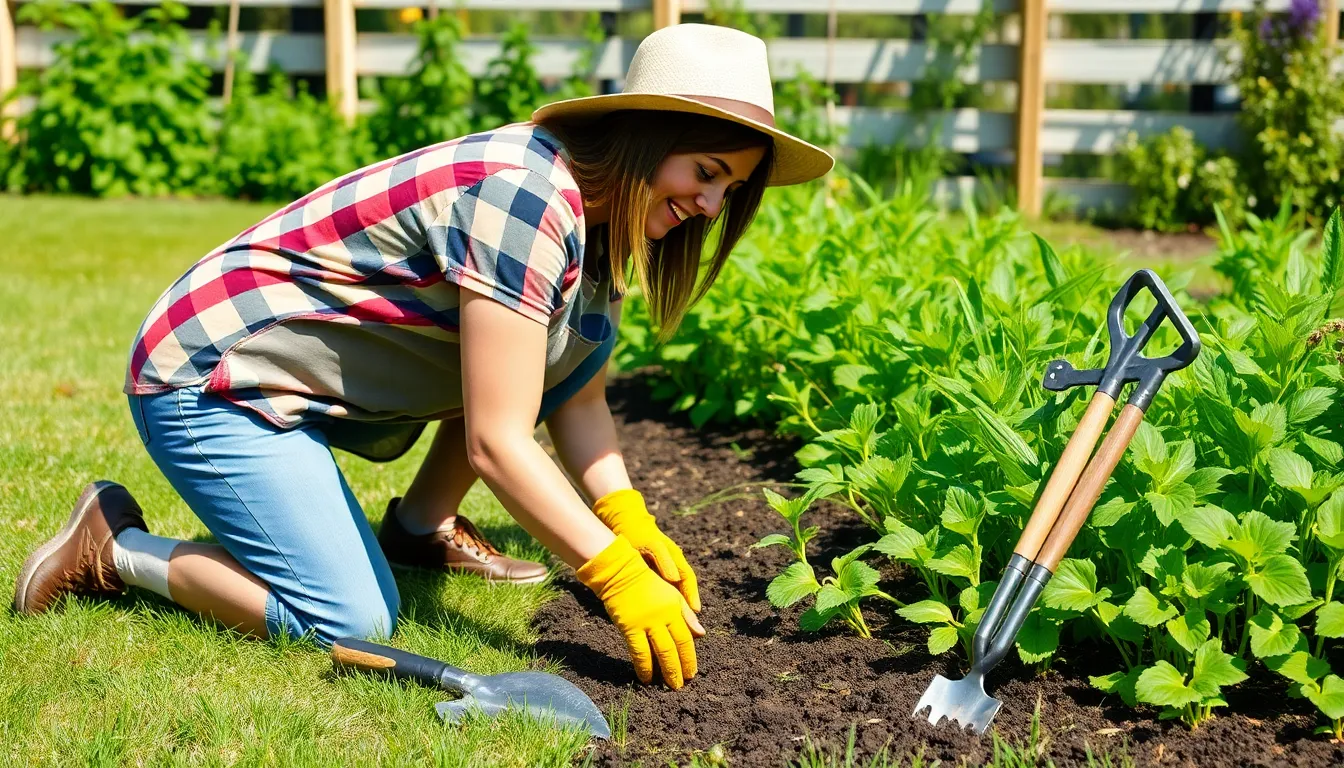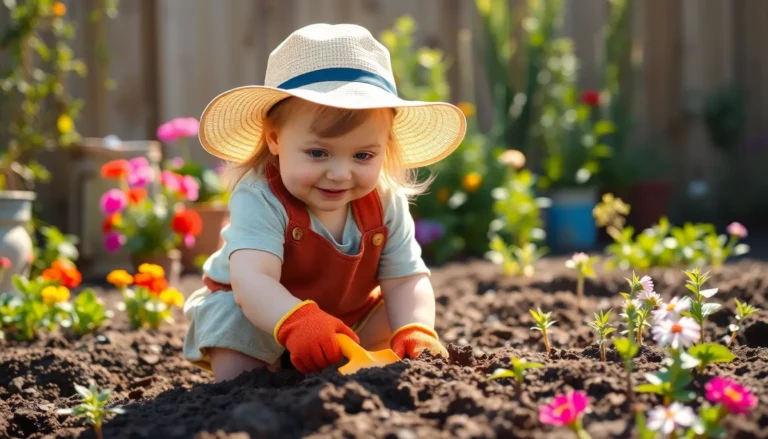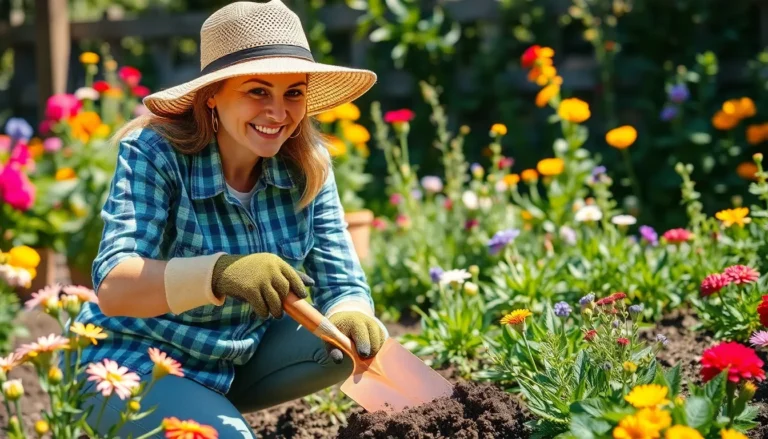Every gardener knows that weeds are like uninvited guests at a party—they show up unannounced and quickly take over the fun. But fear not! With the right weeding tools in hand, anyone can reclaim their garden from these pesky invaders. From trusty hand tools to innovative gadgets, the world of weeding is filled with options that can make the task feel less like a chore and more like a victorious battle.
Weeding Tools For Garden
Different tools exist to help gardeners tackle weeds effectively. These tools range from traditional hand options to modern power devices, ensuring every gardener can find the right fit for their needs.
Hand Tools
Hand tools play a crucial role in weed management. Gardeners often rely on tools like hoes, trowels, and hand forks. Hoes excel at digging, cutting through the soil, and uprooting weeds. Trowels offer precision for removing weeds around delicate plants. Hand forks assist in loosening soil, making it easier to extract stubborn roots. Each tool serves a purpose, allowing gardeners to tailor their approach based on the weed species and garden conditions.
Power Tools
Power tools offer an efficient alternative for larger gardens or heavy infestations. Electric weeding tools streamline the process of weed removal and save time. For instance, gas-powered weed eaters tackle dense patches quickly. Cordless models provide flexibility without cords getting in the way. These innovations reduce physical strain and enhance productivity, allowing gardeners to cover more ground with less effort. Each tool enhances the overall gardening experience by making weeding tasks quicker and simpler.
Choosing The Right Weeding Tool

Selecting the appropriate weeding tool involves considering several important factors. Proper tools not only simplify the process but also enhance gardening efficiency.
Consider Your Garden Size
Garden size significantly affects tool selection. Smaller gardens benefit from hand tools, which allow for precise control in tight spaces. For larger plots, power tools become more practical, enabling quicker weed removal with less physical effort. An efficient approach combines both types, utilizing hand tools for detail work among delicate plants and power tools for open areas. Understanding the dimensions of the garden helps in choosing the right blend of tools for effectiveness.
Think About the Soil Type
Soil type influences tool effectiveness. Loose, sandy soils respond well to traditional hand tools, which can easily penetrate and uproot weeds. Clay soils, however, may require stronger tools designed to break through tough textures. Identifying the soil composition enables gardeners to select tools that match their specific needs. Those with rocky soils might need specialized weeding devices equipped to handle obstacles. Adapting tool choices based on soil characteristics leads to successful weed management.
Techniques For Effective Weeding
Effective weeding involves understanding timing and employing proper techniques. These strategies can enhance results and reduce effort.
Timing Your Weeding Sessions
Timing affects the success of weeding efforts. Early morning or late afternoon offers cooler temperatures, making it easier to pull weeds. Weeds tend to be more pliable after rain, so plan sessions following precipitation. Observing weed growth patterns also proves beneficial; tackling weeds before they seed can prevent future infestations. Weekends may provide ample time, but a few minutes on weekday evenings can keep gardens manageable.
Proper Weeding Techniques
Employing the right techniques can make weeding easier. Start by grasping the base of the weed and pull upward, ensuring the root comes out completely. Using a weeding tool, such as a hand fork, can help remove weeds deeply rooted in the soil. A gentle rocking motion may loosen stubborn weeds without disturbing surrounding plants. For larger areas, consider the hoe for quick surface scraping. Additionally, mulching after weeding protects soil moisture and prevents weed resurgence. Following consistent techniques leads to a healthier garden.
Maintenance Of Weeding Tools
Maintaining weeding tools enhances their lifespan and efficiency, enabling gardeners to tackle weeds effectively.
Cleaning Your Tools
Clean tools after each use to prevent soil and plant diseases from spreading. Use a mixture of water and mild soap, scrubbing off dirt with a brush. Rinsing tools thoroughly follows this step to ensure no soap residue remains. Drying implements with a cloth or letting them air dry helps prevent rust. For stubborn soil, soaking tools in a bucket of soapy water for a few hours offers a complete clean. Regular maintenance of tools not only facilitates better performance but also ensures a healthier garden environment.
Storage Tips
Proper storage prolongs the life of weeding tools and keeps them ready for use. Store tools in a dry, cool place to prevent moisture-related damage. Hanging tools on hooks or placing them in a designated toolbox organizes them effectively. Ensure that sharp blades are covered or sheathed to prevent injuries and maintain edge quality. For wooden handles, applying linseed oil protects against drying and cracking. Organizing tools neatly reduces clutter and allows for quick access during gardening sessions.
Conclusion
Effective weeding is crucial for maintaining a healthy garden. By selecting the right tools tailored to specific needs gardeners can tackle unwanted plants with confidence. Whether opting for hand tools for precision or power tools for efficiency larger areas the choice greatly impacts the weeding experience.
Incorporating proper techniques and timing further enhances the effectiveness of these tools. Regular maintenance ensures longevity and optimal performance allowing gardeners to keep their tools in top shape. With the right approach and tools at hand gardening becomes less of a chore and more of a rewarding endeavor.




